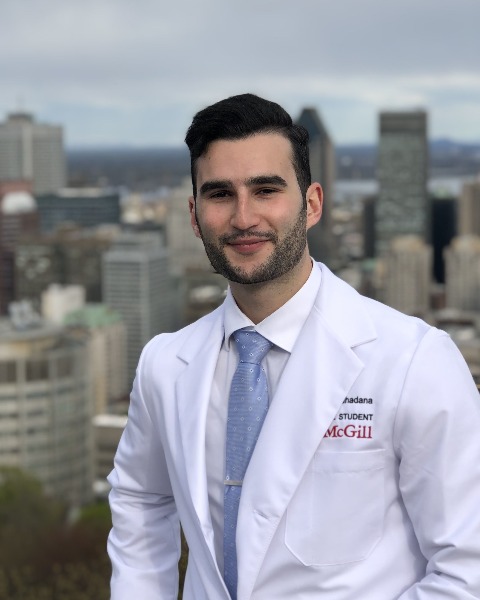Back
Poster, Podium & Video Sessions
Moderated Poster
MP29: Benign Prostatic Hyperplasia: Surgical Therapy & New Technology III
MP29-04: Effect of Surgeon Volume and Facility Volume on Outcomes of Benign Prostatic Hyperplasia Surgery
Saturday, May 14, 2022
1:00 PM – 2:15 PM
Location: Room 225
David-Dan Nguyen, David Bouhadana*, Montreal, Canada, Michelina Stoddard, Xinyan Zheng, Jialin Mao, New York, NY, Naeem Bhojani, Montreal, Canada, Bilal Chughtai, New York, NY

David Bouhadana
McGill University, Faculty of Medicine and Health Sciences
Poster Presenter(s)
Introduction: Surgical volume is intimately associated with better operative outcomes, both at the surgeon and facility level. However, there is limited evidence on such a relationship for transurethral resection of the prostate (TURP) and laser procedures for benign prostatic hyperplasia (BPH). As such, we report the effect of surgeon and facility volume on outcomes of TURP and laser treatment of BPH. We also present demographic predictors of treatment at high-volume facilities.
Methods: We used New York State Department of Health Statewide Planning and Research Cooperative System (SPARCS) data. We included adult patients who underwent TURP or laser in the outpatient setting between January 2005 and December 2016. Average annual surgeon and facility combined volumes of TURP and laser procedures were calculated and broken down by tertile (low-volume, medium-volume, and high-volume). Adjusting for baseline demographics, the effect of volume on short-term outcomes (30-day and 90-day readmission) was examined using mixed-effect logistic regression models with random intercept at the facility level. Cox proportional-hazard models with a robust variance estimator accounting for patients’ cluster at the facility level were used for long-term outcomes (stricture and reoperation).
Results: We included 34,444 patients. Among those, 21,074 (61.2%) underwent laser procedures and 13,370 (38.8%) underwent TURP. Both higher facility volume and surgeon volume were associated with lower odds of readmission. Treatment at high-volume facilities was also associated with lower hazards of developing stricture. Outcomes by surgeon and facility volume adjusting for patient demographics are presented in Table 1. High-volume surgeons operating at high-volume facilities had better short-term outcomes and lower hazards of reoperation compared to high-volume surgeons working at low-volume facilities (all pint <0.05). Statistically significant predictors of treatment at high-volume facilities included Medicaid insurance (OR 0.44, 95% CI 0.38-0.51, p<0.001) and white race (OR 1.62, 95% CI 1.52-1.73, p<0.001).
Conclusions: Higher surgeon and facility volume are associated with lower odds of readmission, with higher facility volume also associated with lower hazards of developing strictures. There are interactions between surgeon volume and facility volume suggesting that the effect of surgeon experience on outcomes is modified by their facility’s volume. Medicaid insurance and Black race were associated with higher odds of treatment at low-volume facilities, highlighting disparities in access to high-volume BPH centers.
Source of Funding: N/a
Methods: We used New York State Department of Health Statewide Planning and Research Cooperative System (SPARCS) data. We included adult patients who underwent TURP or laser in the outpatient setting between January 2005 and December 2016. Average annual surgeon and facility combined volumes of TURP and laser procedures were calculated and broken down by tertile (low-volume, medium-volume, and high-volume). Adjusting for baseline demographics, the effect of volume on short-term outcomes (30-day and 90-day readmission) was examined using mixed-effect logistic regression models with random intercept at the facility level. Cox proportional-hazard models with a robust variance estimator accounting for patients’ cluster at the facility level were used for long-term outcomes (stricture and reoperation).
Results: We included 34,444 patients. Among those, 21,074 (61.2%) underwent laser procedures and 13,370 (38.8%) underwent TURP. Both higher facility volume and surgeon volume were associated with lower odds of readmission. Treatment at high-volume facilities was also associated with lower hazards of developing stricture. Outcomes by surgeon and facility volume adjusting for patient demographics are presented in Table 1. High-volume surgeons operating at high-volume facilities had better short-term outcomes and lower hazards of reoperation compared to high-volume surgeons working at low-volume facilities (all pint <0.05). Statistically significant predictors of treatment at high-volume facilities included Medicaid insurance (OR 0.44, 95% CI 0.38-0.51, p<0.001) and white race (OR 1.62, 95% CI 1.52-1.73, p<0.001).
Conclusions: Higher surgeon and facility volume are associated with lower odds of readmission, with higher facility volume also associated with lower hazards of developing strictures. There are interactions between surgeon volume and facility volume suggesting that the effect of surgeon experience on outcomes is modified by their facility’s volume. Medicaid insurance and Black race were associated with higher odds of treatment at low-volume facilities, highlighting disparities in access to high-volume BPH centers.
Source of Funding: N/a

.jpg)
.jpg)